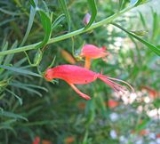
Eremophila decipiens
Encyclopedia
Eremophila decipiens is a shrub
which is native to Australia
. It is also known as Slender Fuchsia, although it is not closely related to the Fuchsia
.
var. linearifolia by botanist Spencer Moore
in 1920 in the Journal of the Linnean Society. The following year another botanist, Carl Hansen Ostenfeld
classified this former variety as a species in its own right.
Shrub
A shrub or bush is distinguished from a tree by its multiple stems and shorter height, usually under 5–6 m tall. A large number of plants may become either shrubs or trees, depending on the growing conditions they experience...
which is native to Australia
Australia
Australia , officially the Commonwealth of Australia, is a country in the Southern Hemisphere comprising the mainland of the Australian continent, the island of Tasmania, and numerous smaller islands in the Indian and Pacific Oceans. It is the world's sixth-largest country by total area...
. It is also known as Slender Fuchsia, although it is not closely related to the Fuchsia
Fuchsia
Fuchsia is a genus of flowering plants that consists mostly of shrubs or small trees. The first, Fuchsia triphylla, was discovered on the Caribbean island of Hispaniola in 1703 by the French Minim monk and botanist, Charles Plumier...
.
Description
This species usually grows to between 0.1 and 1.8 metres in height. It produces red, orange or yellow flowers between February and December in Australia (late summer to early summer).Taxonomy
The species was originally published as Eremophila maculataEremophila maculata
Eremophila maculata , also known as Spotted Emu Bush or Native Fuchsia, is a shrub which is native to Australia.-Description:...
var. linearifolia by botanist Spencer Moore
Spencer Le Marchant Moore
Spencer Le Marchant Moore was an English botanist.Moore was born in Hampstead. He worked at the Royal Botanic Gardens, Kew from about 1870 to 1879, wrote a number of botanical papers, and then worked in an unofficial capacity at the Natural History Museum from 1896 until his death.Moore is...
in 1920 in the Journal of the Linnean Society. The following year another botanist, Carl Hansen Ostenfeld
Carl Hansen Ostenfeld
Carl Emil Hansen Ostenfeld was a Danish systematic botanist. He graduated from the University of Copenhagen under professor Eugenius Warming. He was a keeper at the Botanical Museum 1900-1918, when he became professor of botany at the Royal Veterinary and Agricultural College...
classified this former variety as a species in its own right.

